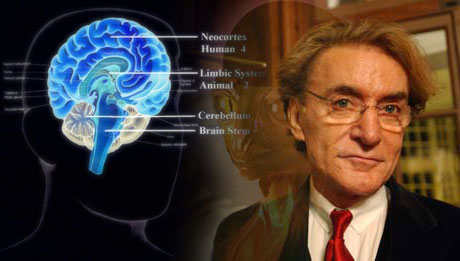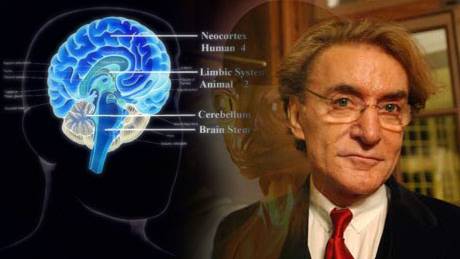Clotaire Rapaille - Reptilian Marketing (Video)
Source: pbs.org
Watch the entire PBS's Frontline program "The Persuaders": here.
Each year, legions of ad people, copywriters, market researchers, pollsters, consultants, and even linguists—most of whom work for one of six giant companies—spend billions of dollars and millions of man-hours trying to determine how to persuade consumers what to buy, whom to trust, and what to think. Increasingly, these techniques are migrating to the high-stakes arena of politics, shaping policy and influencing how Americans choose their leaders.
Read the entire interview with Clotaire Rapaille here.
Crack This Code
By Danielle Sacks | fastcompany.com

G. Clotaire Rapaille has guided Chrysler, Procter Gamble, Boeing, and other enraptured clients through the "collective unconscious" of dozens of cultures. Now he's taking on India. Is he a sage--or a charlatan?
It's day four of our journey into the heart of India's culture, and we're holed up inside the sprawling Bangalore Oberoi hotel. Somehow, this immaculately manicured property blocks out the offensive cocktail of sandalwood and diesel that overwhelms your senses when you're actually navigating the anarchic streets of India's high-tech capital. It makes you forget that India has no personal space, or that 300 million of its people live on less than a dollar a day.
So on this afternoon, instead, India comes to us. Even before the research session begins, participants reveal centuries-old cultural tics. Women are wound in rich greens and hot pinks, oranges and golds; the men are a colorless contrast, swathed in grays and beiges and blacks. Asked to sit themselves in a circle, they self-organize: Men and women take to opposite sides of the room, with the oldest of both sexes seated together.
This surely means something, and eventually, the Frenchman in black cowboy boots watching via a monitor in the next room will explain what that meaning is. G. Clotaire Rapaille will crack India's code, as he has dozens of others. He will explain what makes this intricate country and its people tick and, not incidentally, how to do business there. And for that intelligence, the corporate clients who have traveled to India with him, including executives from DuPont and luxury goods group Richemont, will reward him handsomely.
Rapaille is a market researcher, political scientist, medical anthropologist, and cultural shrink. Armed with Freudian and Jungian psychoanalytical theory, he seeks to tap a people's "collective unconscious," revealing what it means to be Japanese, German, or most recently, Chinese. "The code is like an access code: How do you punch the buttons to open the door?" Rapaille says, revealing a pungent accent. "Suddenly, once you get the code, you understand everything. It's like getting new glasses."
This stuff doesn't fly well in scholarly circles. Richard A. Shweder, a University of Chicago professor of cultural anthropology and psychology, likens Rapaille's methodologies to "the soft porn of irrationalism." (Rapaille, for his part, dismisses academics out of hand: "They only have ideas. They don't have any results.") And his New York-based firm, Archetype Discoveries Worldwide, seems amateurish at times. (I discovered that the woman leading the Bangalore focus group, for example, was also his live-in personal chef; "he and his wife prefer light fare like salads," she told me.)
Yet Rapaille's corporate portfolio is as extravagant as his black velvet suits and Rolls-Royces. He's not shy about boasting that "50 of the Fortune 100 companies" are his clients, that he has "cracked 35 codes" for P&G, and that he is author of "14 books." Companies pay Rapaille between $125,000 and $225,000 to crack cultures, product categories, or brands across cultures. (What, for example, does toilet paper mean to Americans versus the Japanese?) He gets $30,000 per 45-minute speech.
Indeed, many clients regard him with a zeal more often reserved for a cult leader. Listen to Mike Jensen, GMAC Insurance's chief brand officer: "For us, [Rapaille's findings] created a sense of identity and noble purpose." Or to Ed McQuigg, who directs strategy and marketing for Richemont: "Whenever you can… go for a walk with him, let your mind run and ask him one question after another, and you will learn things about life."
One question comes to mind over and over: Is Rapaille for real? I traveled to India with him looking to decode one of the world's last great growth markets: "The next China's" mushrooming middle class, after all, is nearing 300 million, creating an enormous opportunity for consumer brands and retailers. Yet its 5,000-year history, its 1 billion inhabitants, and its 15 official languages also make it, if not impenetrable to outsiders, then certainly challenging. Rapaille promised insight. And that, I certainly got.
As the session begins, Rapaille perches, legs crossed, within inches of the monitor, furiously scribbling in a journal with a quote from Gandhi taped to the interior flap. His swooping amber hair grazes a finely tailored black suit; he sports a watch on each wrist--one for local Indian time, the other for New York.
"Does India still have a caste system?" the moderator asks the group. The Indians take the bait, shouting "no!" or "yes!" as the room explodes into raucous debate.
"Hahaaaaaa!" Rapaille exclaims, like a detective stumbling onto critical evidence. "Do you hear that?" His clients nod, thinking he's talking about the fascinating details of India's enigmatic caste system. But Rapaille is hearing something entirely different--the dramatic change in the intensity of the conversation. "Remember," he warns, "I never believe what people say. I want to understand why people do what they do."
According to Rapaille, we all have an alibi. Our alibis are the ways we explain our motivations--the surface responses typically served up in market research. Which is why, he argues, focus groups don't work. To get to the "why," Rapaille stages something closer to a three-hour psychotherapy session--where participants ultimately find themselves lying in fetal position on the floor being asked to channel their earliest childhood memories.
Rapaille subscribes to the triune brain theory, which describes three distinct brains: the cortex, limbic, and reptilian. Beneath the cortex, the seat of logic and reason, is the limbic, which houses emotions. Camouflaged underneath those is Rapaille's baby--the reptilian--the layer wired by our biological primal needs like sex, reproduction, and survival.
"The reptilian always wins"--that's Rapaille's mantra. "So you have to discover the reptilian hot button, whatever you want to do--design an airplane, sell diamonds--what is the reptilian brain?" Whereas bad advertising only taps into the cortex ("Buy this paper towel to clean up a spill!"), mediocre ads appeal to the cortex and the limbic ("Buy this paper towel to clean up a spill and reduce stress!"). But truly effective campaigns nail all three ("Buy this paper towel to clean up a spill, reduce stress, and satisfy your maternal reptilian desire to relieve your son's shame at making the spill in the first place!").
Find out what Indians' earliest reptilian associations are with what it means to "be Indian," says Rapaille, and you've cracked the Indian code. By feeding the group concepts like "caste system," he's looking for patterns and structures that are true across the culture. In this case, Rapaille observes, Indians are at root a practical people. While they claim to be strict rule followers, for example, their political system is corrupt, and business and educational institutions are riddled with bribery. In the Hindu religion, Rapaille says, "you can buy [gods], you can bribe them, you can change gods depending on what you need." Even on India's streets, no one abides by traffic rules. "Deep down they're just practical," he says. Rapaille is quick to point out that these insights aren't positive or negative, or even judgments, but merely expose the flexible, adaptable structure of the Indian people. So the caste system--which to most of the world seems oppressive--is for Indians a triumph of practicality, clearly signaling to all their places in a complex society. "It's not a problem, it's a solution," he concludes, oozing a mischievous grin.
The first time Rapaille visited India, he recalls, he drove from Paris in a rickety Citroën. It was 1964; he was a 23-year-old grad student, broke, so he camped in his car for a month. By his second trip, nearly 25 years later, he was worth millions of dollars and piloting his own helicopter.
The saga is all about theater and contrast, like all of Rapaille's tales. He talks of his childhood in Normandy during World War II, when his father and grandfather were captured by the Germans (now he owns a ninth-century Norman castle). There's the one of becoming a TV celebrity in France during the late 1970s, only to abandon fame to chase the American dream. (He moved to the United States 30 years ago and lives in a mansion in Tuxedo Park, New York. He proclaims, "I am more Amer-ee-khan than other Amer-ee-khans, because I choose to become an Amer-ee-khan!")
He repeats these stories so frequently, so indiscriminately--with seemingly choreographed brow gestures and verbal exclamation points--that the line between fact and mythology feels blurry after a time. What's really real, and what has simply acquired authority by constant, unchallenged retelling?
Rapaille's favorite tale, and the one most frequently recycled by corporate devotees, starts with his study of autism. As a young psychologist in Switzerland, he says, he tried to determine why autistic children couldn't grasp language. He discovered a link to emotional experience, leading him to posit that each language really was a unique set of inherited associations. Understand those associations, he said, and you've unlocked a culture's DNA.
This autism theory has long been considered outdated within academia. Says one expert: "Frasier Crane [the TV shrink] may accept it." But in the early 1970s, a Nestlé executive heard Rapaille lecture in Geneva and connected the idea to a business problem. He asked Rapaille to help Nestlé introduce its Folgers coffee into tea-drinking Japan--to crack the coffee code.
Rapaille ditched his autism research. "I realized working with a business environment was fantastic because they were implementing my theories, and I could see my theories in action with the results right away," he says. Indeed, his consulting snowballed--L'Oréal, Johnson & Johnson, and Renault sought him out. French president Pompidou, he says, asked him to crack the code for nuclear energy.
The project Rapaille flaunts most avidly is his work on Chrysler's PT Cruiser, the retro sedan introduced to acclaim in 1999. Rapaille says he advised Chrysler to design something people would either love or hate. To be "on code" across different cultural markets, he says, Chrysler connected with America's "I do" ethos via an aggressive Al Capone design, and with the "I think" psyche of France by marketing the Cruiser as infused with "ideas"-- like a luggage area that can be converted into a table. ("I discover the code, and--bingo!--the car sells like crazy.")
Talk to Chrysler, though, and it sounds as if Rapaille is inflating his contributions. "Absolutely he was involved… as one form of validating our design," says Sam Locricchio, a Chrysler spokesman. "But to take full credit for sales and success is not correct." Chrysler isn't the only one to call Rapaille out. Douglas Rushkoff, author of Get Back in the Box, says Rapaille's persona eerily echoes that of Ernest Dichter, a psychologist from Europe who in the 1950s introduced marketers to psychoanalytical techniques out of his lavish New York estate. "The thing that makes Clotaire so striking to me is how closely he modeled his whole pitch on Dichter and how well his technique works on marketers," says Rushkoff. "He appeals to these executives on the most base level of their most childlike needs for comfort and authority and a sweet, eccentric French uncle."
Rapaille, clearly irritated by the comparison, says that, though similar, Dichter's work was rooted in the individual unconscious while "I'm speaking about the universal collective unconscious." In any case, he has little time or patience for such criticism. His latest book, The Culture Code (Broadway Books) will appear in June. He plans to start a university (online, that is--and outsourced to India) where anyone can become a code-cracking aficionado. And he lets on that he's developing a television show where he'd crack the codes of individuals--everyone from Madonna to Bono. "This," he says, "is why I love Amer-ee-kha!"
Rapaille picks me up on Manhattan's 42nd Street in his silver PT Cruiser, sporting one black driving glove. It has been more than a month since we parted ways in Mumbai, the last stop of the Indian code-cracking journey.
The mood among his clients during that trip's final days had swung between optimistic and skeptical. A few who had traveled with him before tried to reassure doubtful newcomers that Rapaille finishes strong (the "Indian code" won't be unveiled until March, and then only for clients). Others hypothesized that Rapaille concocts the code before he even hits the road and just drags everyone along for show. "Ze cheese is dead!" (a hyperbolic finding for Danone that cracked the American code for le fromage) became an inside joke after Rapaille retold the anecdote relentlessly. "I think he's an amazing bullsh--ter," says one exec. "He's got some talent, but… he latched onto an idea X many years ago, and it was a damn good one, and he's milking this one idea for all it's worth."
"Ready for the anthropological journey?!" Rapaille asks, stepping on the gas. He's whisking me away to Jackson Heights in Queens to demonstrate how he "opens the file"--his way of verifying the structures of the culture through every angle of Indian life: from Bollywood to birth rates. If the code is correct, he says, you should be able to find evidence everywhere. Otherwise, "you have the wrong code."
We arrive in Queens, and Rapaille lurches to a stop at a generic shop named Roosevelt Gift Bags and Luggage. He darts inside for a minute, then returns. "The Chinese guy told me 74th Street. That's where the Indians are!" A few blocks later, he finally spots a Himalayan restaurant and we park along a strip dotted with Sikh jewelry stores, sari shops, and restaurants. He hops out of the Cruiser. "See the turbans," he says, pointing. "Red, green, blue…"
In a supermarket, he wanders the aisles, touching bags of spices and rice as if trying to divine a Ouija board. Then we enter a sari shop, where he asks the salesgirl to show him a Sikh wedding dress. "My wife would love this," he smiles. As we pass jewelry shops, he keeps pointing out, "See Ganesha; Ganesha is always in the window!"
I keep waiting for him to say something profound, to deliver insight. But aside from repeating the few observations he had shared in India, there's nothing. After all of 20 minutes, Rapaille informs me that the visit is over. He has to meet his wife for dinner--and they're not eating vindaloo.
Back at my office that night, I call Ajay Mookerjee, the executive director of Harvard Business School's new India Research Center, who's based in Bangalore. I share with him Rapaille's take on Indian rules and pragmatism, corruption, and the caste system, hoping for some perspective.
And of course, Mookerjee disputes it all. "Sitting in his lakeside villa, it looks like he's getting quite used to spinning theories about other people. I don't think he has quite understood the Indian psyche here," he says. I'm not surprised. No one enjoys hearing their culture reduced to stereotypes. And it's difficult to digest Rapaille's theories if you aren't used to thinking about culture in psychoanalytic terms. Nevertheless, the conversation reinforces what I'd come to suspect: Rapaille is 25% substance and 75% shtick.
And yet, as we're wrapping up, Mookerjee mentions an article he read that morning about America's inability to embrace a zero-defects policy. "Unlike Japan," he tells me, "they don't like to be right the first time. Americans love to fail… they like to learn from mistakes… I thought that was fascinating." After we hang up, it dawns on me that Mookerjee was referring to the American code. He didn't realize it, but the insightful article he had recommended actually was one I had emailed him. The subject: G. Clotaire Rapaille.
Article from: http://www.fastcompany.com/magazine/104/rapaille.html






















